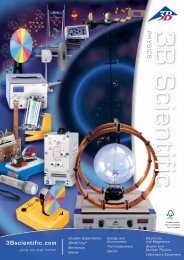3B Scientific - Physics & Engineering Experiments
3B Scientific - Physics & Engineering Experiments
3B Scientific - Physics & Engineering Experiments
You also want an ePaper? Increase the reach of your titles
YUMPU automatically turns print PDFs into web optimized ePapers that Google loves.
UE5010200<br />
Atomic physics /<br />
Introductory experiments in atomic physics<br />
Planck’s constant<br />
UE5010200<br />
BASIC PRINCIPLES<br />
The photoelectric effect exhibits two important properties, which were<br />
discovered in 1902 by Lenard. The number of electrons emitted from<br />
the cathode material as a result of the photoelectric effect is proportional<br />
to the intensity of the incident light. However, the energy is<br />
dependent on the frequency of the light and not on its intensity. In<br />
1905, Einstein used a hypothesis based on the description of black body<br />
radiation discovered by Planck to explain this and thereby laid important<br />
foundations for quantum mechanics.<br />
h f<br />
e-<br />
U 0<br />
Einstein assumed that light propagates in the form of photons possessing<br />
energy proportional to the frequency of the light. If a photon of energy<br />
(1) E = h⋅ f,<br />
h = 6.626 x 10- 34 Js: : Planck’s constante<br />
strikes an electron inside the cathode material, its energy can be transferred<br />
to the electron, which is then emitted from the cathode with kinetic energy<br />
pA<br />
Fig. 1: Schematic of set-up for measurements<br />
E / zJ (1 zJ = 10 -21 J)<br />
(2)<br />
E kin<br />
= h⋅ f −W<br />
100<br />
The work W required for emission of the electron is a quantity which is<br />
dependent on the nature of the material, its value for caesium for example<br />
is approximately 2 eV.<br />
50<br />
E X PERIMEN T<br />
PROCEDURE<br />
• Measure the cut-off value of the decelerating<br />
voltage as a function of the<br />
wavelength of light.<br />
• Plot the results in a graph of energy<br />
against frequency.<br />
• Determine Planck’s constant and the<br />
work required to emit an electron.<br />
• Demonstrate that the energy of the<br />
electrons does not depend on the<br />
intensity of the light.<br />
OBJECTIVE<br />
Determine Planck’s constant using the decelerating voltage method<br />
SUMMARY<br />
In a modified version of a classic set-up, light of known frequency passes through a ring-shaped anode<br />
to collide with a cathode, where it causes electrons to be released due to the photo-electric effect. The<br />
energy of the electrons can be determined by applying a decelerating voltage, which compensates<br />
for the flow of electrons towards the anode until no electrons are flowing. This demonstrates that the<br />
cut-off value of the decelerating voltage which corresponds to a current of zero is not dependent on<br />
the intensity of the light. The energy of the electrons is therefore similarly independent of intensity. By<br />
obtaining the cut-off voltages for light of varying frequency, it is possible to calculate Planck’s constant.<br />
Required Apparatus<br />
Quantity Description<br />
Number<br />
1 Planck’s Constant Apparatus (230 V, 50/60 Hz) 1000537 or<br />
Planck’s Constant Apparatus (115 V, 50/60 Hz) 1000536<br />
In this experiment, the above relationship is used to determine Planck’s<br />
constant h. Light of a specific frequency f passes through a ring-shaped<br />
anode and strikes a cathode, causing electrons to be released. The resulting<br />
current from cathode to anode is then measured using a nanoammeter and<br />
a decelerating voltage U 0 is applied in order to reduce the current to zero.<br />
The light from various LEDs is used. The spectrum of the respective components<br />
is sufficiently narrow that a distinctive wavelength λ can be assigned<br />
to each of them, from which the frequency can be obtained as follows:<br />
(3)<br />
f = c λ<br />
c =2.998x10 8 m/s<br />
The intensity of the light from the diodes can be varied between 0% and<br />
100%, meaning that it is possible to investigate how the energy of the electrons<br />
depends on the intensity of the light.<br />
EVALUATION<br />
In each case, the current is compensated to a value of zero at the cut-off<br />
value of the decelerating voltage U 0 . This definition can be summarised<br />
using equations (2) and (3) as follows<br />
U 0<br />
/ mV<br />
600<br />
400<br />
200<br />
0<br />
450 500 550 600 650<br />
f / THz<br />
(1 THz = 10 12 Hz)<br />
Fig. 2: Graph of energy against frequency<br />
472 nm<br />
505 nm<br />
525 nm<br />
588 nm<br />
611 nm<br />
0<br />
0% 20% 40% 60% 80% 100%<br />
F / F 0<br />
Fig. 3: Cut-off voltage U 0 as a function of intensity<br />
e ⋅U 0<br />
= h⋅ f −W = h⋅ c λ −W<br />
where e=1.602 x 10 -19 As: elementary charge<br />
1<br />
Planck’s constant can therefore be determined from the slope of a graph<br />
where values E = e ⋅U 0<br />
are plotted along the y-axis and values of f = c λ<br />
are plotted along the x-axis.<br />
202<br />
<strong>3B</strong> <strong>Scientific</strong>® <strong>Experiments</strong><br />
...going one step further 203















